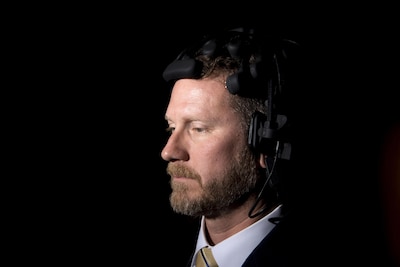By Shannon Collins DoD News, Defense Media Activity
WASHINGTON, Nov. 30, 2017 — A Defense Department study on
the benefits of surfing for patients with post-traumatic stress. A clinical
tracking tool used to manage patient care. An advanced electroencephalogram and
eye tracker.
The Defense and Veterans Brain Injury Center's traumatic
brain injury clinic at Naval Medical Center San Diego and the Naval Health
Research Center at Naval Base Point Loma in San Diego are developing and using
cutting-edge research to better help service members, their family members and
retirees.
At the research center, Kristen Walter is conducting DoD's
first research study of its kind on the psychological and physical effects of a
surf therapy program for patients with post-traumatic stress disorder and other
issues. Almost 70 active duty and reserve component patients from all service
branches, primarily the Marine Corps and the Navy, participated in the study.
“Initial results suggest that both PTSD and depression
symptoms improve for those affected with the disorders,” Walter said. “We’ve
also found our strongest effects are improvements in positive effect and
decreases in negative effect. We assess individuals before and after each surf
therapy session.”
After this first study, she added, she and her team will
look into not only the effects not only of surfing therapy, but also of hiking
and other recreational therapies that would be accessible for more patients.
She said she has personally noticed the change in the patients.
Sense of Community
“There’s definitely a sense of community here in addition to
the surf therapy," she added. “It improves mood, makes people feel better
-- more connected to the environment and also to other people.”
Patients typically undergo standard psychotherapies for
psychological disorders, but recreational outlets offer them an alternative,
Walter said.
“Some people don’t benefit from our standard
treatment," she explained. "Getting people actively engaged in their
environment, doing things that matter to them -- that’s incredibly important
for mental and physical health. It’s really important to study those effects.”
The team designed the algorithm for the clinical tracking
tool with Navy Seal patients because of the Seals’ high operations tempo, said
Dr. Lars Hungerford, senior clinical research director for DVBIC.
“We created an algorithm and a tool so that we can screen
them while they’re still overseas so we’ll know how many people we’ll need to
see [and] get them set up so that when they hit the ground here, they’re all
set up and running. We can just move on from there,” he said.
On the Same Page
While a patient is undergoing treatment at the hospital,
Hungerford said, all of the different specialists who see the patient will put
in their notes and appointments and see the patient’s goals so that everyone is
on the same page.
“For example, when we first see a patient, we do an intake,
meet as a team and come up with a treatment plan for what that person
needs," he said. “They need occupational therapy, speech, neuropysch --
that gets put into the referral and gets kicked over to the individual
providers, and then they write up their notes and we track all of their
symptoms in the system.
Coordinating Care
“We see they have a headache goal,” he continued. “According
to the tracking system, we’ve met, and we’re about halfway through the headache
goal, but now they’re complaining more about memory problems, so things might
shift as we go along. You can capture that quickly by looking at this system,
and [all of the providers] can communicate and coordinate care.”
The eye tracker is used to measure saccade response, or
reaction time and speed of response, Hungerford said. The new wireless EEG
prototype is portable and doesn’t require liquid or gel.
“With the old EEGs, you had to put on a lot of gel, and
patients left with a goopy head and had to go home and take a shower,” he said.
“With this prototype, we can apply it within a few minutes and get a nice
reading of the EEG waves. When the sensors touch skin, they don’t have to go
through hair. They’re flat for comfort and don’t have prongs. It’s advanced
technology.”
The new fusion study is using both the eye tracking and EEG
at the same time. “That’s probably something that hasn’t been done,” Hungerford
said. Looking at the different modalities that diagnose TBIs and comparing what
the eyes are doing to what the brain is doing to what the MRI reveals combine
to achieve a better understanding of what is going on with the patients, he
added.






